SOURCE: AFI

The Indian Space Research Organisation (ISRO) has taken a significant leap forward in its space exploration endeavors with the inauguration of a first-of-its-kind large trisonic wind tunnel (TWT) at the Vikram Sarabhai Space Centre (VSSC) in Thiruvananthapuram, Kerala. This groundbreaking facility will play a crucial role in optimizing the aerodynamic design of future rockets and spacecraft, paving the way for a more efficient and cost-effective space program.
The TWT is a unique wind tunnel capable of simulating three distinct flight regimes: subsonic (below the speed of sound), transonic (at the speed of sound), and hypersonic (above the speed of sound). This versatility makes it an invaluable tool for testing the aerodynamic performance of scaled-down models of rockets and re-entry spacecrafts under various atmospheric conditions.
The TWT offers several advantages for ISRO:
- Improved Design and Efficiency: By analyzing the aerodynamic behavior of models in the TWT, ISRO engineers can optimize the design of rockets and spacecraft, leading to enhanced performance and fuel efficiency.
- Reduced Development Costs: The TWT provides a cost-effective alternative to expensive, real-world flight testing, allowing ISRO to iterate and refine designs more efficiently.
- Positioning India at the Forefront: With the TWT, India joins the ranks of a select few nations, including the US and France, with the capability to test at hypersonic speeds. This strengthens India’s position as a leading player in the global space race.
The TWT adds to India’s existing wind tunnel infrastructure, which includes the Defence Research and Development Organisation’s hypersonic wind tunnel and the National Aerospace Laboratories’ 1.2-meter TWT. This comprehensive network of facilities allows India to conduct comprehensive testing across various speed ranges, further solidifying its commitment to space exploration advancements.